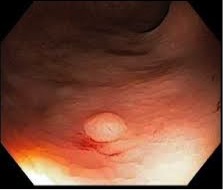WBR0918
Jump to navigation
Jump to search
| Author | PageAuthor::Vendhan Ramanujam | ||||||||||
|---|---|---|---|---|---|---|---|---|---|---|---|
| Exam Type | ExamType::USMLE Step 3 | ||||||||||
| Main Category | MainCategory::Primary Care Office, MainCategory::Inpatient Facilities | ||||||||||
| Sub Category | SubCategory::Gastrointestinal, SubCategory::Surgery | ||||||||||
| Prompt | [[Prompt::A 48 year old Caucasian male presented to his primary care physician with the complaint of an episode of passing blood along with his stool. He had no prior history of a similar illness or a colonoscopy. He had no family history of colon cancer. He denied smoking and taking alcohol. His vital signs were heart rate 92 beats/min, respiratory rate 16/minute, blood pressure 110/70 mm Hg and oral temperature 37.2 C. Physical examination was unremarkable. Laboratory examination showed a normal complete blood count and a normal metabolic panel. The patient was referred for a colonoscopy, which revealed a solitary polyp as shown below
| ||||||||||
| Answer A | AnswerA::Repeat colonoscopy after 1 year | ||||||||||
| Answer A Explanation | AnswerAExp::'''Correct'''-Polyps with non-infiltrating carcinoma should be followed up with a repeat colonoscopy after 1 year because of the increased risk of relapse. | ||||||||||
| Answer B | AnswerB::Repeat colonoscopy after 3 years | ||||||||||
| Answer B Explanation | [[AnswerBExp::Incorrect-Adenomatous polyps >1 cm in size or multiple (>2) polyps in number or villous type or with a high grade dysplasia should be followed up with a repeat colonoscopy after 3 years. If it is negative, another repeat colonoscopy should follow after 5 years.]] | ||||||||||
| Answer C | AnswerC::Repeat colonoscopy after 5 years | ||||||||||
| Answer C Explanation | [[AnswerCExp::Incorrect-Adenomatous polyp <1 cm in size or ≤2 polyps in number or tubular type or without a high grade dysplasia carriers a low risk of neoplastic conversion and it should be followed up with a repeat colonoscopy after 5 years.]] | ||||||||||
| Answer D | AnswerD::Repeat colonoscopy after 10 years | ||||||||||
| Answer D Explanation | AnswerDExp::'''Incorrect'''-Hyperplastic polyps should be followed up with a repeat colonoscopy after 10 years. | ||||||||||
| Answer E | AnswerE::Repeat colonoscopy after 15 years | ||||||||||
| Answer E Explanation | AnswerEExp::'''Incorrect'''-Repeat colonoscopy after 15 years is not the correct approach to any of above scenario. | ||||||||||
| Right Answer | RightAnswer::A | ||||||||||
| Explanation | [[Explanation::Polyps with non-infiltrating carcinoma should be followed up with a repeat colonoscopy after 1 year to look for a relapse.
Educational Objective: Colonoscopic surveillance of colonic polyps is as follows
Educational Objective: | ||||||||||
| Approved | Approved::Yes | ||||||||||
| Keyword | WBRKeyword::Colonic polyp, WBRKeyword::Adenomatous polyp, WBRKeyword::Villous polyp, WBRKeyword::Tubular polyp, WBRKeyword::Hyperplastic polyp | ||||||||||
| Linked Question | Linked:: | ||||||||||
| Order in Linked Questions | LinkedOrder:: |
